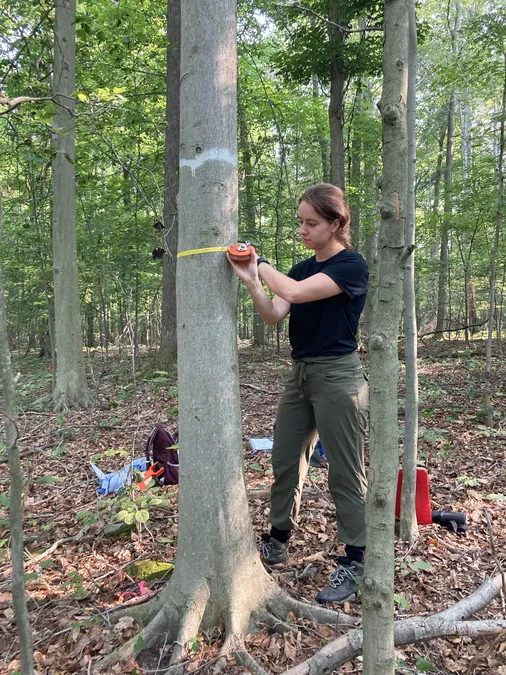
Urgent Warning: 30% of Beech Trees Decimated by Rapidly Spreading Leaf Disease!
2025-03-24
Author: Wei Ling
A Groundbreaking Study on Beech Leaf Disease
A groundbreaking study by researchers at The Holden Arboretum has unveiled alarming revelations about the state of American beech trees (Fagus grandifolia) a decade after the onset of beech leaf disease (BLD) in northeast Ohio. The research indicates that a staggering 30% of these majestic trees have succumbed to the disease, signaling potential long-term devastation for eastern North American forests.
Publication and Findings
Published in the journal Trees, Forests and People, this pivotal study is the first to accurately measure the long-term impacts of BLD on beech trees, relying on a unique data set compiled annually since before the disease was first detected in the region. The research highlights that of the 263 American beech trees monitored in Cuyahoga County, a concerning trend has emerged: mortality rates have spiked dramatically, particularly in the last three years.
Exponential Surge in Tree Deaths
“We observed an exponential surge in tree deaths, especially among saplings, with mortality rates peaking at 14% in 2022 alone,” reports Brianna Shepherd, a research specialist at Holden Forests & Gardens and lead author of the study. This urgent call for action reveals the critical health crisis facing our forests.
The Invasive Nematode
The culprit behind this devastation is the invasive nematode Litylenchus crenatae subsp. mccannii, which causes the telltale darkened and distorted leaves on infected trees, crippling their ability to photosynthesize by as much as 60%. Initially identified in Lake County, Ohio, in 2012, BLD has since spread to affect 15 states across the U.S. and has reached Ontario, Canada.
Long-Term Growth Decline
In a further blow to these venerable trees, the study reported a significant decline in growth rates following the arrival of BLD. “This is a slow-moving crisis,” warns David Burke, co-author and Vice President for Science and Conservation at Holden. “While beech leaf disease may not kill trees as quickly as other pests, the compounded effects—slower growth, energy loss, and increasing mortality—will devastate beech-rich forests over time.”
Mortality Rates and Soil Health
Interestingly, the research highlighted that higher mortality rates were recorded in plots with dense beech populations. This suggests that overcrowding or the transmission of the disease could exacerbate stress on the affected trees. However, in a ray of hope, mortality was somewhat lower in plots treated with limestone and phosphate, hinting at a potential connection between soil health and tree resilience.
Long-Term Monitoring Data
This research is particularly impactful as it draws from long-term monitoring data at Case Western Reserve University's Squire Valleevue Farm in Hunting Valley, Ohio, which was fortuitously established in 2009 to study soil nutrient effects. The comprehensive dataset enabled scientists to track the disease’s progression meticulously, a luxury that many forest disease studies lack.
The Need for Ongoing Monitoring
"Our long-term dataset allows us to clearly see the impact of BLD from its inception to nearly a decade into its spread," notes Katie Stuble, co-author and Director of Research at Holden. “This research is a stark reminder of the urgent need for ongoing monitoring as BLD expands, especially combined with other stressors like beech bark disease and the effects of climate change.”
A Species in Decline
As we observe the gradual decline of a species that forms the backbone of many eastern forest ecosystems, the findings underscore a pressing need for further research and intervention. "It’s heartbreaking, but with every study, we're inching closer to potential solutions," emphasizes Shepherd.
A Call to Action
The clock is ticking as this foundational species faces unprecedented challenges—will we rise to the occasion before it’s too late? Stay tuned for more updates on this critical environmental issue!




 Brasil (PT)
Brasil (PT)
 Canada (EN)
Canada (EN)
 Chile (ES)
Chile (ES)
 Česko (CS)
Česko (CS)
 대한민국 (KO)
대한민국 (KO)
 España (ES)
España (ES)
 France (FR)
France (FR)
 Hong Kong (EN)
Hong Kong (EN)
 Italia (IT)
Italia (IT)
 日本 (JA)
日本 (JA)
 Magyarország (HU)
Magyarország (HU)
 Norge (NO)
Norge (NO)
 Polska (PL)
Polska (PL)
 Schweiz (DE)
Schweiz (DE)
 Singapore (EN)
Singapore (EN)
 Sverige (SV)
Sverige (SV)
 Suomi (FI)
Suomi (FI)
 Türkiye (TR)
Türkiye (TR)
 الإمارات العربية المتحدة (AR)
الإمارات العربية المتحدة (AR)